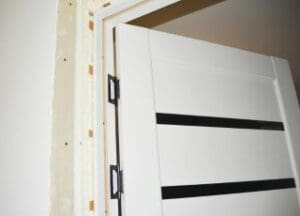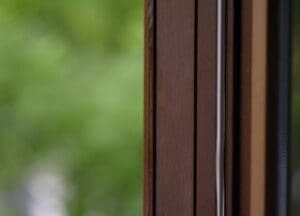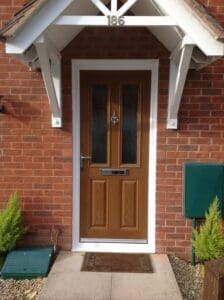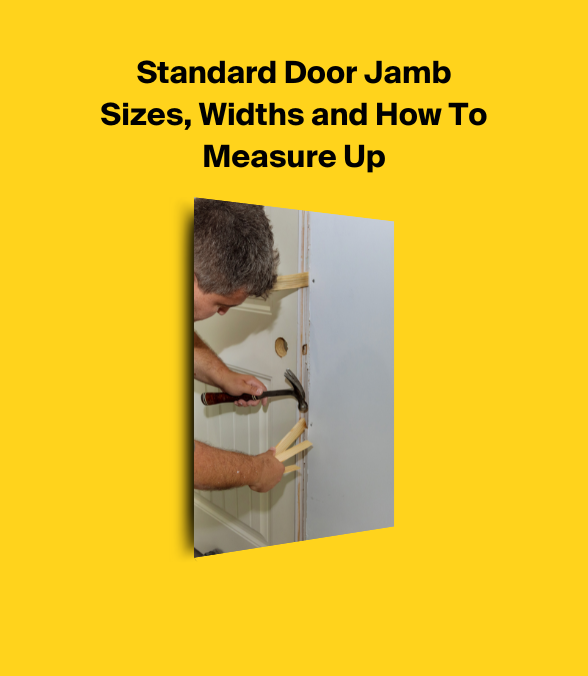Standard Door Jamb Sizes, Widths and How To Measure Up?
Imagine installing a brand-new door, only to find it doesn’t close properly or has gaps and drafts.

The cause of these issues could be an improperly measured door jamb width.
To avoid such problems and ensure a smooth installation process, it’s essential to understand and measure your door jamb width.
If you are getting a new door, let Value Doors take care of it.
A free survey before any installation for external doors to ensure a perfect fit and security.
Design and order your door online below now:
Short Summary:
- Understanding door jamb width is key for a successful installation.
- Professional tools like measuring tape and level are needed to measure door jamb width accurately.
- Expert advice and professional services ensure proper measurement & installation of the correct door jamb width.
Understanding Door Jamb Width
Door jamb width plays an essential role in door installation, providing stability and support for the door itself. A well-measured door jamb ensures proper functioning and contributes to the overall aesthetics of your space.
This section dives into the importance of door jamb width, its definition, and standard measurements.
What is a Door Jamb?
A door jamb, also known as a door frame, is the vertical frame component that provides support and stability for a door, whether interior or exterior.
It serves a vital purpose: attaching the hinges on a door and holding the strike plate for the door’s latch, which is essential for a fully functioning standard door width.
Door jambs come in various dimensions, which are crucial for determining the appropriate door size and installation type.
In addition to door jambs, door frames also play a significant role in a standard door's overall functionality and aesthetics.
Understanding the difference between pre-hung interior and exterior double doors can further enhance our knowledge of door jambs. Sun Mountain supplies pre-hung interior double doors.
These doors feature a single flush bolt at the top of the inactive door. Pre-hung exterior double doors come with flush bolts, one at the top and another at the bottom of the inactive door.
In comparison, regular double doors have no such locking mechanism.
Read more about the different parts of a door and frame here
Standard Door Jamb Width
Standard door jamb widths typically measure 4 9/16-inches, 5 12-inches, and 6 9/16-inches.
However, these measurements can vary depending on wall thickness and the type of door.
For instance, the thickness of exterior or interior walls can impact the required door jamb width, which is crucial for determining the rough opening size.
When selecting the appropriate door jamb width, it’s essential to consider the wall thickness, type of door, and compatibility of the door and jamb width.
This ensures a proper fit and helps avoid common door jamb width issues, like doors not shutting correctly or gaps and drafts, especially with taller doors.
Measuring Door Jamb Width Accurately
Accurate door jamb width measurement is the key to a successful door installation and proper door function.
This section discusses the essential tools needed for precise measurement and walks you through the measuring process.
Measuring the door jamb width is simple and requires a few essential tools. You’ll need a tape measure, a pencil, and a level. Start by measuring the width of the door.
Tools Needed
A few essential tools are required to determine the door jamb width accurately:
A measuring tape to measure the thickness of the door and jamb, a level to guarantee accurate measurements, and a pencil to mark the measurements on the door jamb, similar to how a door lintel can be measured.
These tools apply whether you’re working with external doors or internal doors.
Measuring Process
Measuring door jamb width involves several essential steps. First, you’ll need to measure the width and height of the door opening and the size of the door itself.
For the most precise measurement, removing the casing and brick mould is recommended to visualize the space between the stud and the jamb.
This allows you to accurately measure the door jamb width from the interior of the wall stud to the interior of the wall stud, adding 1/8 inch to ensure a secure fit.
Furthermore, determining door handling is an essential aspect of the measuring process. To do this, stand in the doorway and position your back against the jamb of the door where the hinges will be placed.
If the door is intended to open to the left, it’s a “left-hand” door, while if it’s designed to open to the right, it’s a “right-hand” door.
Factors Affecting Door Jamb Width
Several factors can affect the required door jamb width, such as wall thickness and the type of door.
In this section, we’ll delve into the different factors that influence door jamb width and provide guidance on selecting the appropriate width for your specific situation.
Wall thickness is one of the most important factors when determining the door jamb width. The thicker the wall, the wider the door jamb needs to be. The type of door also matters.
Wall Thickness
Wall thickness is a primary determinant of door jamb width. The thickness of the wall directly affects the width of the door jamb required for a proper fit.
Standard interior walls typically have a door jamb width of 4 9/16 inches, while load-bearing walls constructed of 2x6s require a wider door jamb width of 6 9/16 inches.
It’s crucial to accurately measure wall thickness to select the appropriate door jamb width.
This ensures a proper fit and helps avoid potential issues that could arise from an incorrect door jamb width, such as gaps and drafts or difficulty closing the door.
Type of Door
Different types of doors, such as interior, exterior, and French doors, may require varying door jamb widths.
The thickness of the door and its compatibility with the jamb width can affect the required door jamb width.
Understanding the specific requirements of your door type and considering them when selecting the appropriate door jamb width will help ensure a seamless installation and optimal door performance.
Selecting the Right Door Jamb Width
Selecting the right door jamb width is essential for proper door function and aesthetics.
In this section, we’ll discuss the importance of matching door and jamb width and customization options for non-standard door sizes and unique installation requirements.
For standard door sizes, the jamb width should match the door width. This ensures the door fits snugly in the jamb and operates appropriately for non-standard purposes.
Matching Door and Jamb Width

Matching the door and jamb width is crucial for a seamless installation and optimal door performance.
By ensuring that the door and jamb widths are compatible, you can avoid issues such as gaps or difficulties in closing the door.
Properly measuring the door and jamb widths is essential for a successful installation.
Measure the width of the door and jamb at the top, middle, and bottom to ensure proper spacing.
Customisation Options
Non-standard door sizes and unique installation requirements may call for customization options.
Custom-made doors can accommodate specific situations, such as older homes with narrow doorways, taller door requirements, or particular design preferences, while still fitting into an existing door space.
A new door with custom dimensions can be the perfect solution for these scenarios.
By exploring customisation options and working with professionals to ensure accurate measurements and proper installation, you can achieve the perfect door for your space.
Troubleshooting Common Door Jamb Width Issues
Troubleshooting ordinary door jamb width issues can help improve door function and longevity.
In this section, we’ll discuss issues such as doors not closing correctly, gaps, drafts, and a guide on addressing these concerns.
The issue may be related to the door jamb width for doors that don't close properly. If the jamb width is too narrow, the door may not be open.
Door Not Closing Properly
A door not closing properly may indicate an issue with the door jamb width or alignment. In such cases, inspecting the door jamb width is advisable to ensure it is the appropriate size.
If it is not, modifying the jamb width, planing the door, or replacing the door may be necessary.
Gaps and drafts
Gaps and drafts around the door may result from incorrect jamb width or poor installation. If you notice such issues, assess the door jamb width to ensure it is of the appropriate size.
If not, adjustment of the jamb width or door replacement may be necessary.
You may also be able to insulate your door by covering these gaps up, stopping any draughts from coming through.
Professional Help for Door Jamb Width Concerns
Professional help can provide expert advice and installation services for door jamb width concerns, ensuring a smooth and successful door installation process.
In this section, we'll discuss the advantages of expert advice and professional installation services for addressing door jamb width issues.
Expert Advice
Seeking expert advice can help you determine the appropriate door jamb width for your specific situation and requirements.
Professionals can guide you through the measuring process, assist with selecting the right door jamb width, and troubleshoot any issues that may arise during installation.
Having the right door jamb width is essential for a successful installation. It ensures that the door fits properly and securely in the frame and that it opens and closes smoothly with the right advice.
Installation Services
Professional installation services can ensure proper door jamb width measurement and installation, resulting in optimal door function and longevity.
You can benefit from their expertise and experience by utilising professional installation services.
Avoiding potential problems arising from inaccurate measurements or installation is also a key benefit of using professional installation services.
Summary
Understanding and accurately measuring door jamb width is essential for a successful installation and optimal door function.
You can ensure a smooth and aesthetically pleasing door installation by considering factors such as:
Wall thickness and door type, selecting the right door jamb width and addressing common issues like doors not closing correctly and gaps and drafts.

Remember, professional help is always available to provide expert advice and installation services for all your door jamb width concerns.
Frequently Asked Questions
Does door jamb width matter?
Yes, door jamb width does matter.
An improper size can prevent the door from closing correctly, leading to drafts and potential insect infestations entering your home.
Therefore, it is essential to ensure that the door frame is of appropriate width, much like the door's threshold.
What is the width of a door frame in the UK?
Regarding door frames in the UK, the standard internal size is 762mm for England and Wales and 726mm for Scotland.
This size can be adjusted to suit a range of door sizes, with pre-assembled frames or parts that can be cut as required.
How wide is the door jamb trim?
Based on industry standards, door jamb trim for interior doors typically ranges from 4 5/8-inches to 6 3/4-inches in-depth.
This allows for adequate room between the trim and the wall, ensuring a secure fit and a professional look.
How do I know what size door jamb I need?
By taking measurements of the opening width wall to wall and then adding 18 inches, you can determine what size door jamb you need for a proper fit.
This ensures the jamb will fit, even if the drywall is thicker than expected.
What is the importance of accurately measuring door jamb width?
Accurately measuring door jamb width is essential for a successful door installation, allowing the door to fit correctly and swing in its frame without any obstruction.









